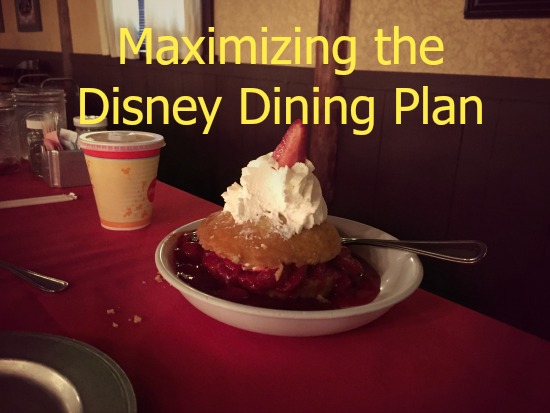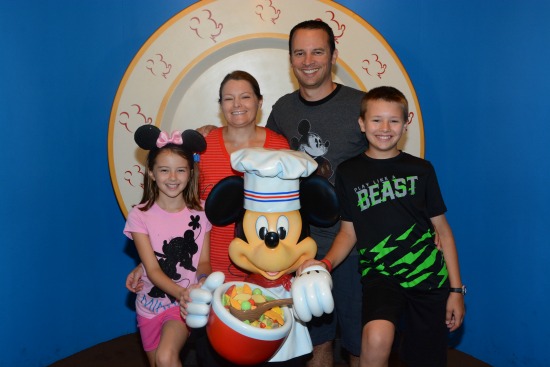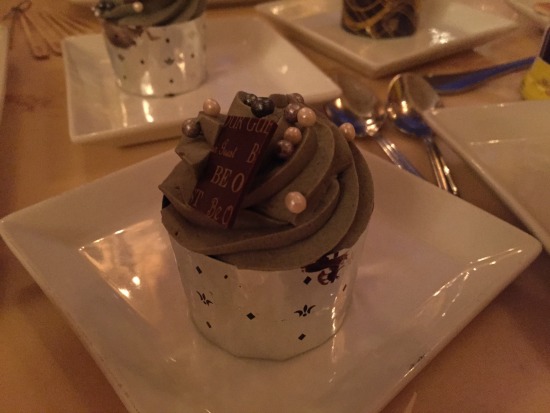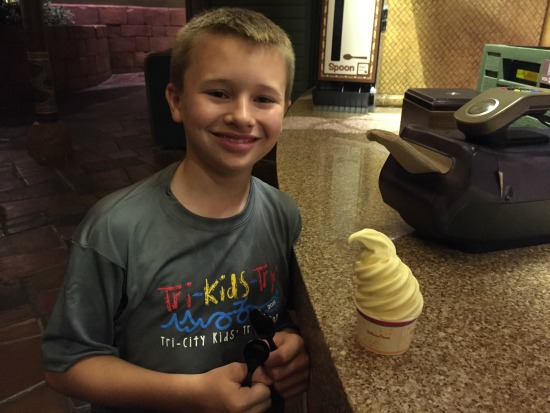There is a lot of information out there in whether or not the Disney Dining Plan is a good value. There are arguments to be made both ways. In many cases, what you pay for the plan isn’t a good value when compared to what you would have spent in cash for the same food. But there are many reasons guests purchase the Disney Dining Plan. You may have received it free or at a reduced rate as part of your total package. Or you might like the comfort of knowing exactly how much your vacation is going to cost before you pack your bags. Or you might just be convinced by friends, a travel agent, or even by Disney that it is a good value.

This post doesn’t get into the financial equation, but presents the information from the standpoint that you have purchased the Disney Dining Plan and want to know how to maximize its value.
The Disney Dining Plan
The standard (or “plus”) Disney Dining Plan provides each person in your party 1 table service meal, 1 quick service meal, and 1 snack (2016) or 2 snacks (2017) per day. It also provides each person with a refillable mug that can be used at any of the resorts (but not the theme parks or water parks). The 2017 cost of the Disney Dining Plan is $67.33 per adult per night and $24.22 per child (age 3-9) per night.
Table Service Credits
A table service meal at Walt Disney World is one where you are seated at a table and waited on by a server. There are more than 50 table service locations throughout Walt Disney World Resort. The Disney Dining Plan includes one entrée, one dessert, and one non-alcoholic drink per table service credit. Children ages 3-9 are required to order from the children’s menu at table service restaurants. (Children under 3 may eat free from an adult’s plate.) Some table service meals are buffets or served family-style, which makes them “all you can eat” and provide a non-alcoholic drink.

Everyone gets their photo taken before being seated at Chef Mickey’s.
Maximizing the value of a table service meal on the Disney Dining Plan can be tricky. But these tips can help you out:
- Character meals are typically more expensive than non-character meals and, with one exception, use one table service credit per person. The exception is Cinderella’s Royal Table in Magic Kingdom, which requires two table service credits, making it a poor use of your dining plan credits.
- Go for the more expensive items on the menu. Some of the lower-cost items (I’m looking at you, macaroni & cheese) tend to be worse values on the dining plan.
- Use your table service credits at lunch or dinner rather than breakfast (with the exception of character meals, see #1 above). Breakfast does not include a dessert, and breakfast typically costs less than lunch or dinner.
- Don’t use your credits at Signature restaurants. These take two credits per person. When you do the math, the cost of two single-credit table service meals is usually less than the cost of one signature meal or dinner show. Example: Le Cellier Steakhouse’s New York Strip has a current price tag of $50; add $15 for a soda and a dessert ($65 total) and you have each credit worth $32.50. A steak, drink, and dessert at Rose & Crown in Epcot (using a single credit) would run you about $40.00, making it a better dollar-for-dollar value.
- Don’t use it on in-room private dining or pizza delivery at your resort. They will subtract two credits from your balance for this option.
Quick Service
A quick service meal at Walt Disney World is one where you order your food at a counter or register and find your own seating. There are multiple locations in the theme parks, water parks, resorts, and Disney Springs. The Disney Dining Plan includes one entrée and one non-alcoholic beverage for each quick service entitlement. (In 2016, a quick service credit also includes a dessert; this is eliminated in 2017 in favor of providing an extra snack credit.) Quick service credits can be mixed and matched among family members regardless of age; this enables children to order from the regular menu.

The “Grey Stuff” from Be Our Guest in Magic Kingdom
Maxing the value of a quick service meal on the Disney Dining Plan is an easier prospect than table service meals. But there are a few tips:
- Go for the more expensive items on the menu. Some of the lower-cost items tend to be worse values on the dining plan.
- Use your quick service credits at locations that provide air-conditioned seating. This tip doesn’t help you with finding extra monetary value, but when you are spending your days sweating in the parks, having a chance to sit in air conditioning can be glorious. Some of the better “air” values include Be Our Guest (Magic Kingdom), Columbia Harbour House (Magic Kingdom), Sunshine Seasons (Epcot), ABC Commissary (Hollywood Studios), Restaurantosaurus (Animal Kingdom), and Pizzafari (Animal Kingdom).
- Visit the higher-quality food locations. This tip also doesn’t help you with finding extra monetary value either, but there can be big differences in food quality among the quick service restaurants. Some of the better “quality” values include Be Our Guest (Magic Kingdom), Columbia Harbour House (Magic Kingdom), Sunshine Seasons (Epcot), Flame Tree Barbecue (Animal Kingdom), and D-Luxe Burger (Disney Springs).
Snacks
Snacks are the most prevalent form of food in Walt Disney World. You can find snacks at kiosks, carts, quick-service restaurants, and even merchandise locations. You will know something counts as a snack credit by finding the snack icon on the menu board or price signage next to the item. Hundreds, if not thousands, of items count as a Disney Dining Plan snack.

One of the most revered snacks in all of Disney World…the Dole Whip
Maximizing the value of a snack on the Disney Dining Plan is fairly simple when following a few tips:
- Like quick service and table service items, go for the more expensive items you find. If something is less than $4.00, it’s probably not worth a snack credit.
- Don’t use snack credits for bottled water. You can get cups of water free in almost any quick-service restaurant by just asking. You can also probably carry a few bottles of water with you in your park bags.
- Like bottled water, you shouldn’t use your snack credits on most kinds of drinks, like soda or other bottled drinks. Their lower costs doesn’t match up to the food items.
- Use it at Starbucks. Each theme park has a Starbucks location: Main Street Bakery (Magic Kingdom), Fountain View (Epcot), Trolley Car Café (Hollywood Studios), and Creature Comforts (Animal Kingdom). Disney Springs also has Starbucks locations. Many of the drinks on the Starbucks menu count as a snack credit, and you can usually add flavor shots with no added cost. Your drink could run in the $7.00-$8.00 range and still count as a snack credit.
- Use it on quality items. Some of the signature Disney World foods count as snack credits, like the Dole Whip (Aloha Isle at Magic Kingdom or Pineapple Lanai at the Polynesian), School Bread from the Norway bakery (Epcot), the Croissant Donut from Refreshment Port in the Canada pavilion (Epcot), Funnel cake at Sleepy Hollow Refreshments (Magic Kingdom), ice cream from the France pavilion (Epcot), and of course Mickey’s Premium Ice Cream Bar (most resorts and parks).
- Goofy’s Candy Co. in Disney Springs. Many of the great items in this store count as snack credits. The store is worth visiting for the sights and smells alone.
Bonus tip: You may find yourself with snack credits remaining on your last day at Walt Disney World. Don’t let them go to waste! Visit the merchandise store in your resort before you board Magical Express and buy some items that you can enjoy on the journey home and even in the weeks to come. My family likes to buy some of the pre-packaged Goofy’s Candy Co. items to keep the Disney magic alive for a few weeks.
Refillable Mug
Every person age 3 and up who is on your resort reservation is entitled to one refillable mug. This mug can be filled in any designated location in your resort (usually a food court, but sometimes there are locations near your resort pool as well). It can also be taken to other Disney resorts and used in their designated food courts and locations. It cannot be used in the theme parks or water parks. There is a chip in your mug that prevents you from filling it more than once every few minutes and from filling it more than 14 days after your resort stay begins.
To maximize the value of your mug, there are just a few tips you can use:
- Use the mugs when dining at your quick service resort location rather than getting a fountain drink when you use a quick service meal credit at the same location. Instead, use your drink entitlement of your quick service meal to buy a bottled drink that can be put in your room’s refrigerator and consumed later (such as by taking it to one of the parks in your park bag).
- If you use your mug in your resort food court, fill it back up with a beverage (non-carbonated if you won’t be drinking it for some time!) on your way out and store it in your resort room refrigerator for later.
Other Considerations
Extending credits across all trip days: On the Disney Dining Plan, you get credits for each night of your resort stay. But if you arrive to your resort early in the day on your travel day and/or leave late on your departure day, you might find yourself in need of an extra meal or two. Adult meal sizes are fairly large, and often you might find you are able to split a meal between two persons or split two meals among three people, thereby saving a few credits here and there. Having a few credits to spare means you can have that “extra” meal on a day when you would normally be out of credits had you used one credit per person per meal.
Everything that is said here is meant to maximize the dollar and quality value of your dining plan credits. But at the end of the day, you have to follow your taste buds and eat at the restaurants that appeal to your family. Eating the things you like trumps everything else.
What are your tips maximizing the Disney Dining Plan? Share your thoughts in the comments.
Incoming search terms:
- how much is disney dining plan
